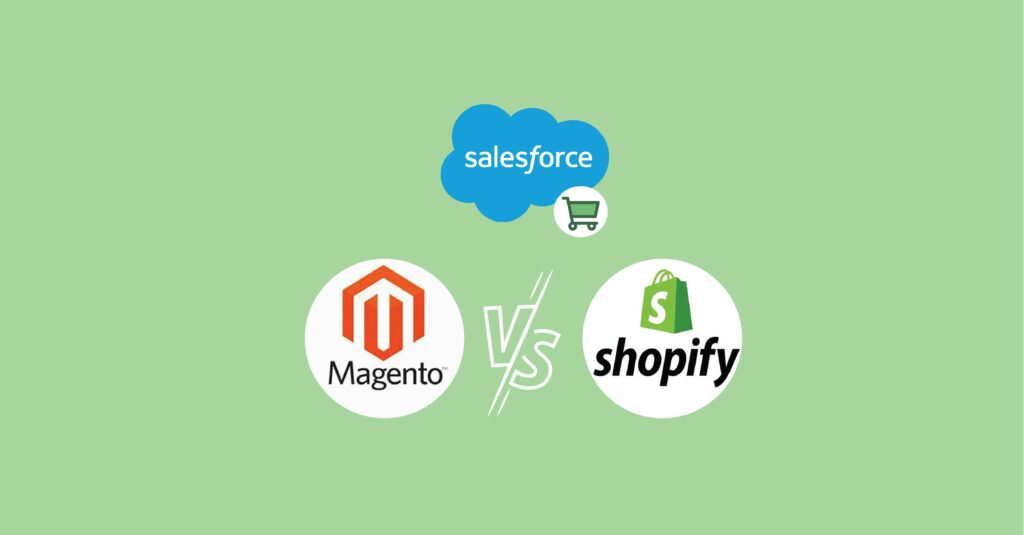In the age of digitization, eCommerce platforms have dominated the internet. Right from ordering food to shopping for groceries, customers prefer online platforms over traditional brick-and-mortar stores. This has increased the need for organisations to set up online storefronts and get on the digital bandwagon.
When it comes to setting up and managing eCommerce ventures, the three platforms that first come to mind are Shopify, Magento, and Salesforce Commerce Cloud (SFCC). All these platforms help organisations make the most of the latest technologies for setting up and managing online stores across multiple platforms.
However, it is often a tough decision for a business to choose an ideal platform among the three. Shopify, Magento, and Salesforce Commerce Cloud have their own sets of pros and cons. Let us have a look at them to understand which platform you should choose to set up your online store(s).
Shopify
Shopify is a highly popular SaaS solution that has been helping businesses build and maintain eCommerce stores for several years. Over time, it has built itself a loyal base of customers due to its consistent and efficient services.
Pros of using Shopify
No hosting requirements
As Shopify is a SaaS platform, there is no need for you to take care of the hosting. Shopify looks after all your hosting needs, making it easy and quick for you to get started.
No PCI compliance for specific payment gateways
With Shopify, you need not focus on PCI compliance while integrating with all payment gateways. You can surpass PCI compliance and remove that burden if you conduct transactions using Shopify payments or Shopify-approved payment gateways.
A wide range of templates
Shopify provides businesses with an array of different templates that can be used to give a specific look and feel to their online storefronts. Based on the products you deal in and the customers you cater to, you can design your Shopify store using the right templates. This makes development faster and more fruitful.
Cons of using shopify
Limited scalability
One of the biggest drawbacks of using Shopify is that it cannot be scaled beyond a limit. Even if the users have subscribed to Shopify Plus, they can expand their stores only to a specific size.
Downtime issues
Several users keep raising complaints about their systems facing downtime issues while using websites built on Shopify. This often affects the website traffic and overall performance of the online stores.
Choosing different elements can get expensive
Every feature that Shopify offers has a price. If you are not aware of what to do and which elements to choose for your online store, you may end up paying a lot.
Magento
Magento is another popular platform for setting up and running eCommerce ventures, especially for medium-to-large enterprises. If you are looking for a highly customizable solution that allows you to make flexible and independent decisions, you can implement Magento within your organisation.
Pros of using Magento
Hosting services in Magento 2
Magento 2 provides users with hosting services, relieving them of the burden of hosting their eCommerce ventures.
Open-source platform
One of the biggest benefits of using Magento is that it is an open-source platform. This makes it highly configurable, allowing users to tailor the platform based on their specific needs and preferences. The high configuration also helps organisations be innovative in their approach to attract more customers and get the desired traction.
Versatile CMS
Magento’s content management system is incredibly flexible and enables users to create, publish, and share original content that is specific to the organisation.
Cons of using Magento
No hosting for all versions
The basic version of Magento does not provide hosting services to users. This often adds to the burden of establishing online stores on the chosen platforms.
CMS is not for everyone.
Despite being versatile, Magento’s CMS is not appropriate for users who are not tech-savvy and knowledgeable about the most recent developments. Every user working with Magento CMS needs to have a working knowledge of HTML to get the work done.
Building designs from scratch
Magento does not provide users with templates that streamline the process of designing online stores. It requires you to build designs and CSS from scratch. This may add to the overall time and effort required to set up your eCommerce venture.
Salesforce Commerce Cloud (SFCC)
Salesforce Commerce Cloud (SFCC) is a cloud-based solution by Salesforce that allows users to build eCommerce ventures and create unified buying experiences across multiple platforms. Irrespective of the scale at which you operate and the industry you belong to, you can implement SFCC within your organisation and avail yourself of its features.
Pros of using SFCC
Fast and easy implementation
Being a cloud-based SaaS solution, Salesforce Commerce Cloud can be implemented within your organisation without any unnecessary delays.
B2B and B2C specialisations
SFCC provides businesses with separate platforms for setting up B2B and B2C ventures. The specialised approach improves the overall efficiency of your eCommerce venture(s).
Connection with Salesforce Suite
A seamless connection with the Salesforce Suite allows SFCC users to obtain benefits offered by features like Einstein (AI component), CRM, workflow management, and more.
Capability to handle load
As an SFCC user, you can rest assured that your website and application will be capable of handling a large volume of load without facing issues like the site slowing down or system downtime.
Insightful analytics
SFCC allows businesses to assess their performance and specific activities by providing them with insightful data-driven analytics. This allows you to make the right business decisions to enhance your online storefronts.
So, which solution is the best?
Looking at the different features and functionalities of Shopify, Magento, and SFCC, it is safe to say that SFCC is an ideal choice if you are looking to build a holistic and responsive eCommerce venture. The platform helps you connect the buying experiences of your customers and manage multiple storefronts from a centralised system. This allows you to drive home the desired traction and build healthy relationships with your customers.










